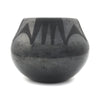
Popovi Da (1922-1971) Biography
Popovi Da was born April 10, 1922. He was named Antonio Jose Martinez but changed his name to Popovi Da meaning Red Fox in 1948. He attended school at San Ildefonso and then at the Santa Fe Indian School where his teachers included Dorthy Dunn and Geronimo Cruz Montoya. Fellow students at the Santa Fe Indian school included Harrison Begay, Allan Houser, Quincy Tahoma, Pop Chalee, Pablita Velarde and and Andy Tsihnahjinnie. It was here that Popovi developed his painting skills, creating works on paper of animals, geometric designs and abstract symbolism.
Popovi was drafted into the army in 1944 and stationed at Los Alamos to work on the Manhatten Project. Popovi's fine technical skills as a painter made him well suited to work on such a highly skilled project. His wife Anita joined him at Los Alamos and after his discharge from the army they returned to San Ildefonso Pueblo to open the Popovi Da Studio of Indian Arts. Not only did the studio offer San Ildefonso pottery Maria and other San Ildefonso potters, but also contained a museum of some of the finest works by Maria and other important Native American artists. In 1952, Popovi was elected governor of the San Ildefonso pueblo.
By 1956 Po became a full partner with Maria in all stages of pottery making. It was Popovi who helped Maria market her work, speaking about the pottery tradition of San Ildefonso at lectures across the country, Popovi began experimenting with polychrome pottery, a departure from the popular black on black pieces and in 1957 won Best in Class Gallup Ceremonial.
In 1961 Popovi created a new two-firing technique resulting in the color sienna. The pottery was fired black, then re warmed and fired again without the smoking process.
Popovi also created a two step firing technique resulting in Black and Sienna on the same vessel. Gunmetal ware was also created by Popovi by using a hotter and longer fire creating a beautiful metallic luster. The firing was extremely difficult and required precise timing to obtain the gunmetal finish.
In 1962 Popovi began creating pieces on his own and he was the first contemporary pueblo potter to add turquoise to his work, a tradition which his son Tony Da continued. It is little known that Popovi also became an accomplished silver smith and jewelry designer.
Not only was Popovi a highly skilled and accomplished artisan, he was also a ceremonial, religious and governmental leader at San Ildefonso. He served as a member of the New Mexico Arts Commission and a member of the School of American Research Board of Managers. Popovi Da died in 1971. His work continues to be highly sought after by collectors.




